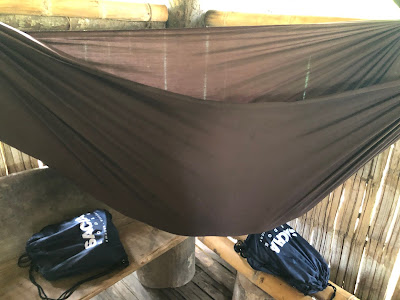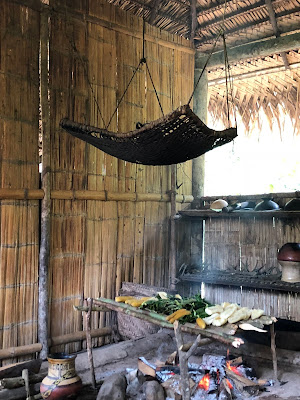From Coca we took a motorized canoe on the Napo River to Sacha Lodge, a private reserve.
Once we arrived at the reserve we were transported in dugout canoes to the lodge on Pilchicocha Lake.
We settled into our cabin and after dark went on an evening walk in the jungle. At six o'clock, just before night fall, the six o'clock cicada begins its chorus.
Our days were filled with exploration. We hiked into the jungle, climbed the observation towers to for bird watching and paddled along the blackwater creeks. Midday we would return to the lodge usually doing as little as possible because it was so humid. Any movement and we would become drenched. It was a strange feeling for me to have sweat dripping off my hands, wrist, and fingertips!
A bird's eye view of the ground only half way up the observation tower.
We were able to spot the lonesome pygmy marmoset some distance away. (He is in the crook of the tree) The pygmy monkey weighs in at only half a pound! These monkeys are usually in groups and it is unknown why this marmoset is alone but they continue to monitor this lonely adult.
And they called this critter a grasshopper!
A crimson headed woodpecker. Although we saw and heard many animals they were just to difficult for my little camera to capture.
Heading down the tower after several hours of bird watching.When we returned to the lodge for lunch, Hubby spotted a family of black-mantled tamarin outside our cabin.
Later we fished for razor-toothed piranha. Although we had many bites our canoe didn't catch a fish. However, another canoe did and we all shared a bite of two of the nine inch, "Man eating" monster, I must say it was quite tasty!
We continued our canoe ride and then wandered into the jungle.The grater palm tree can be covered and used for protection or...
A view from the ground looking up into the canopy.
The iron palm is used for making local furniture.
Bruma tonga broom leaf is used for cooking. They wrap fish, chicken, and vegetables in the leaves and place the packet over the fire to steam.
Bright and early the next morning we crossed the Napo River to the Interpretation Center while paddling we spotted a group of spider monkeys.
The monkeys are hard to see but if you look carefully it is in the center of the photo.The Kichwas are indigenous to the Ecuadorian Amazon. There are about 400 organized communities, each community is usually a family group. In 1992 the government gave the families control over land. Some have chosen to allow oil companies on their land. This particular group has formed the center and only want contact with the outside world within the center.
The roof closest in the photo is the hen house, open air but completely surrounded in wire. The other two buildings are the family home.
Cocoa tree in the "wild"
A small corn field
At the center there are several women with their children in tow, who greeted us and demonstrated the Kichwa way of live. The families wake around 4am, eat breakfast, and work in the forest, or small gardens until mid morning. They then return to their homes and relax. The hot humid climate
dictates limited movement. Because there is no electricity and sunset is
around 6pm it is an early bed time for the families.Mothers keep their toddlers close to them most of the day.
When out in the forest the will often stake a blanket between two trees as a bed for the little ones to sleep in while they work.
These ladies can carry a basket filled with yucca weighing up to eighty pounds and a baby at their side.
Chicha is a fermented drink made of yucca. Originally the maker would spit into the mashed yucca in order to start fermentation but now they use sweet potato. This drink is given to all family members at the beginning of the day. This drink is sometimes the only food they have, the liquid has the ability to make the stomach feel quite full.The children climbed up and around the fire pit with the mothers looking on unconcerned.
The kitchen area.
Roasted beetle larvae...
Hubby was brave enough to try the morsel. It "tasted like chicken" and got stuck in his teeth.
Living on the edge, Hubby tried his hand with the blow gun.Our first spotting of these crested owls was the juvenile above. It flew across our path and had a three foot wing span.
The canopy walk is 120 feet above the forest floor and 940 feet long...
Ninety four feet over the tree tops...
Just about sunset and heading back to the lodge.
The next morning it was time to head back to Quito but before we left we took a photo in the exact spot our grandchildren had been about 15 years before...




















































Comments
Post a Comment